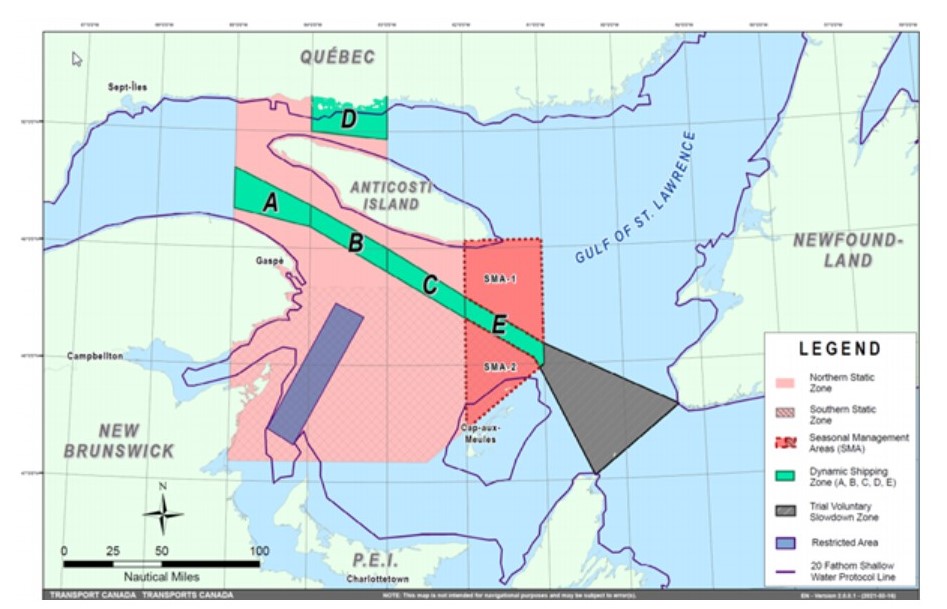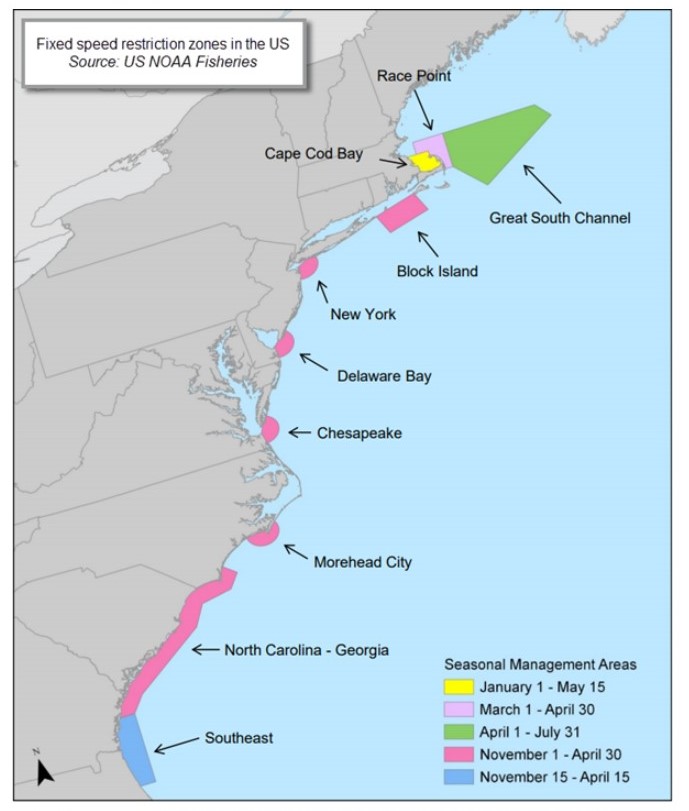Gard Club informs that the North Atlantic right whale is one of the world’s most endangered species of large whale and due to the fact that its habitat and migration routes are located close to major ports, the whales are vulnerable to collisions with vessels.
According to the Gard Club, the North Atlantic right whale is one of the world’s most endangered species of large whale. It was hunted to the brink of extinction by commercial whalers by the early 1890s and the US National Oceanic and Atmospheric Administration (NOAA) estimates that less than 350 right whales remain.
The North Atlantic right whale is found almost exclusively along the East Coast of Canada and the US. Each autumn some right whales travel more than 1,500 km from their feeding grounds off Canada and New England to their calving areas in the warm coastal waters of South Carolina, Georgia, and north-eastern Florida.
Unfortunately, its habitat and migration routes are located close to major ports and often overlap with shipping lanes, making the whales vulnerable to collisions with vessels. Human interactions still represent the greatest danger to the North Atlantic Right whale.
For this reason, both Canada and the US have implemented various measures to prevent vessel strikes during periods when North Atlantic right whales are likely to be present.
#1 Canadian requirements
On 10 March 2022, Transport Canada (TC) announced the vessel traffic management measures that will be enforced in the Gulf of St. Lawrence during the 2022 whale season, which this year extends from 20 April to 15 November. The following restrictions apply to all vessels more than 13 m in overall length (OAL):
- In the Northern and Southern Static Zones, shown in pink in the map below, a fixed mandatory speed restriction of maximum 10 knots is in force during the entire whale season.
- In the Dynamic Shipping Zones A to E, shown in green in the map below, a temporary mandatory speed restriction of maximum 10 knots will enter into force when a right whale is spotted near or in the shipping lanes. This temporary mandatory speed restriction will initially be in force for 15 days but may be extended depending on the presence of whales.
- In the Seasonal Management Areas north and south of the Dynamic Shipping Zone E, shown in dark pink in the map below, a fixed mandatory speed restriction of maximum 10 knots is in force from 20 April to 28 June. From 29 June to 15 November, a temporary mandatory speed restriction of 10 knots will enter into force if a right whale is spotted in the area and will remain in force for at least 15 days.
- A Restricted Area near the Shediac Valley, shown in dark blue in the map below, has been established as larger numbers of North Atlantic right whales normally gathers for feeding and surface activity in this area during the summer months. Vessels more than 13 m in OAL are prohibited from entering the restricted area unless they are on the list of exempted vessels. Exempted vessels, which typically include fishing vessels, governmental vessels, research vessels, vessels in distress, etc., cannot exceed 8 knots when transiting the restricted area. As implementation of the zone restrictions depends on the seasonal fishing activity in the area, TC will communicate the exact timing of this zone to mariners through a navigational warning once decided.
- A Trial Voluntary Speed Restriction Zone, shown in grey in the map below, has been established and spans from Cabot Strait to the eastern edge of Dynamic Shipping Zone E. To coincide with the North Atlantic right whales’ migration in and out of the Gulf of St. Lawrence, a voluntary speed restriction of maximum 10 knots is force in this zone during the periods 20 April to 28 June and 28 September to 15 November.

#2 US requirements
Every year, NOAA implements the following measures along the US East Coast:
- Mandatory ship reporting: Ships of 300 gross tons and above must report to a shore-based station when entering two key right whale habitats: one in the northeast off the coast of Massachusetts and Cape Cod (year-round reporting required) and one in the southeast off the coast of Georgia and Florida (reporting required between 15 November and 16 April). See NOAA’s “Mandatory Ship Reporting System Placard”.
- Fixed speed restriction zones: All vessels 65 feet (19.8 m) in OAL or more must travel at 10 knots or less in certain locations, referred to as seasonal management areas (SMAs), along the US East Coast at certain times of the year.

- Temporary speed reduction zones: Voluntary 10 knot speed restriction zones, referred to as dynamic management areas (DMAs), may be established at short notice when more than three right whales have been sighted within a specific area. Active DMAs will be announced by the NOAA through its customary maritime communication media and mariners are encouraged to avoid these areas or reduce vessels’ speed to 10 knots or less while transiting.
- Right whale slow zones: Similar to the DMAs, right whale slow zones are established around areas where right whales have been recently seen or heard and mariners are encouraged to avoid these areas or reduce vessels’ speed to 10 knots. However, while DMAs are triggered by right whale visual sightings, the slow zones can also be established when right whale detections are confirmed by acoustic receivers.
- Voluntary seasonal ‘Area To Be Avoided’ (ATBA): An ATBA has been established in the Great South Channel and ships of 300 gross tons and above are recommended to avoid the ATBA from 1 April 1 to July 31 when right whales face their highest risk of vessel strikes in this area.
- Recommended shipping lanes: Recommended shipping lanes have been established within Cape Cod Bay (January through May) and in right whale nursery areas off Georgia and Florida (November through April).

#3 Recommended precautions
The Gard Club informs that it is a vessel operator’s responsibility to ensure that its crews are familiar with the risk of vessel collisions with the endangered North Atlantic right whale.
For this reason, the Gard Club recommends Members and clients with vessels trading along the US East Coast and in Canada’s Gulf of St. Lawrence to:
- Make sure crews receive basic training in the precautionary measures to be taken when operating in areas where right whales are known to be present, including identification and reporting. Learn more about the appearance and behavior of North Atlantic right whales from NOAA’s species directory.
Check for active speed reduction zones. Temporary speed reduction zones can be activated at any time of the year if a right whale is confirmed to be in a certain location. - Encourage Masters to reduce the vessel’s speed to 10 knots or less while transiting areas with voluntary speed restrictions (DMAs), or alternatively route around the area, and to post lookouts that are familiar with spotting right whales.
- Review, and update as necessary, vessels’ procedures for pre-arrival reporting to make sure they are in line with the provisions of the US Right Whale Mandatory Ship Reporting System.
- Collect information about right whale sightings from all available sources. This enables crews to conduct the most prudent voyage planning to/from ports in areas where right whales may be present.
- Instruct crews not to intentionally approach within 500 yards (460 m) of a North Atlantic right whale as this is a violation of US federal law. Other vessels in the area should be alerted when a right whale is sighted.





























































